When it comes to innovation, staying ahead of the curve and, sometimes, creating the curve, Frisco remains at the top of its game as it continually evolves into a place where families, businesses and ideas thrive. There are many heroes and professionals behind the scenes working tirelessly to keep up, stay ahead and ensure Frisco adequately and safely handles the demands of the growth we have seen in recent years. That growth has brought astonishing amounts of development throughout the city and opportunities for public service sectors to persistently better themselves while providing the best care and services to visitors and residents.
r
Frisco’s first responders and emergency response personnel are some of the best in the country and work to develop professionally as emergency response teams and first responders. Over the past year, the Frisco Fire Department has done just that as they teamed with other emergency personnel to ultimately create a procedural protocol to handle highly-traumatic injuries in the field before patients are transported to a hospital.
rr
On a daily basis, vehicles and heavy machines are seen all over Frisco, which has, unfortunately, meant an increase in the number of construction-related injuries in the area. Given that increase and that many of those injuries involve such big machinery, the unfortunate chances of injuries being traumatic has also increased and will only continue to increase.
rr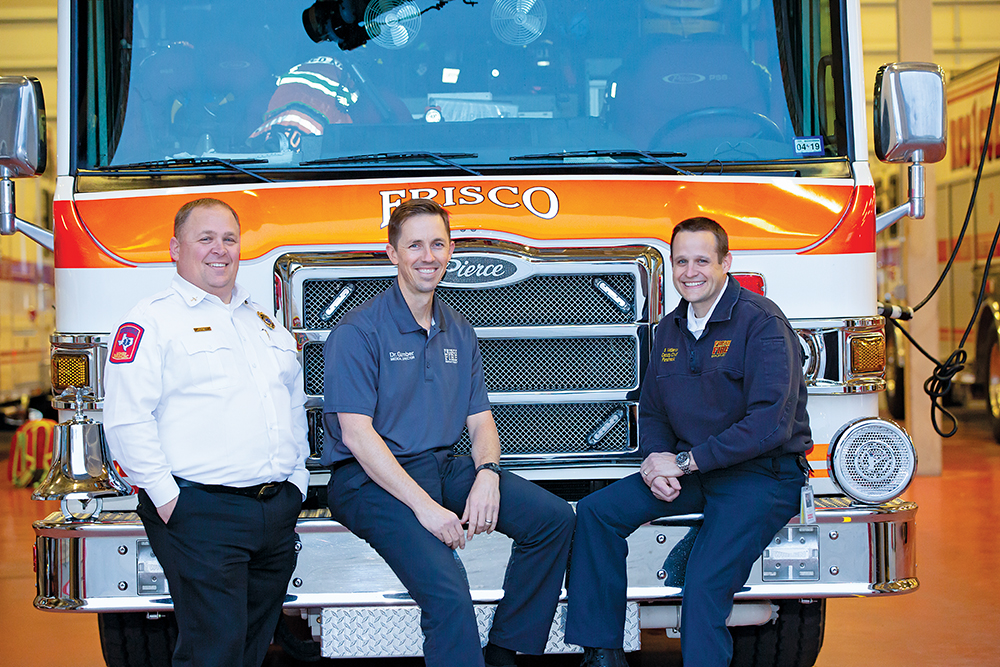
r
Frisco Fire Department Medical Director and Medical City Plano Emergency Room Doctor, Dr. Mark Gamber, along with Frisco Fire Department Deputy Chief Scott Vetterick, knew there was a need for a specific and intensive protocol that would aid our first responders specifically in responding to traumatic injuries that need pre-hospital emergency care. In the timespan of roughly a year, they worked together and set in motion a plan that, in October 2018, ultimately resulted in the creation of a Pre-hospital Amputation Team and Program that would impact both victims and the first responders on scene while increasing a victim’s chance at survival. Little did they know how soon their plan would be put in motion and put to the ultimate test.
rr
February 1, 2018, marks the day the plan proved it worked. First responders and doctors successfully performed a pre-hospital amputation and a local man’s life was saved.
rr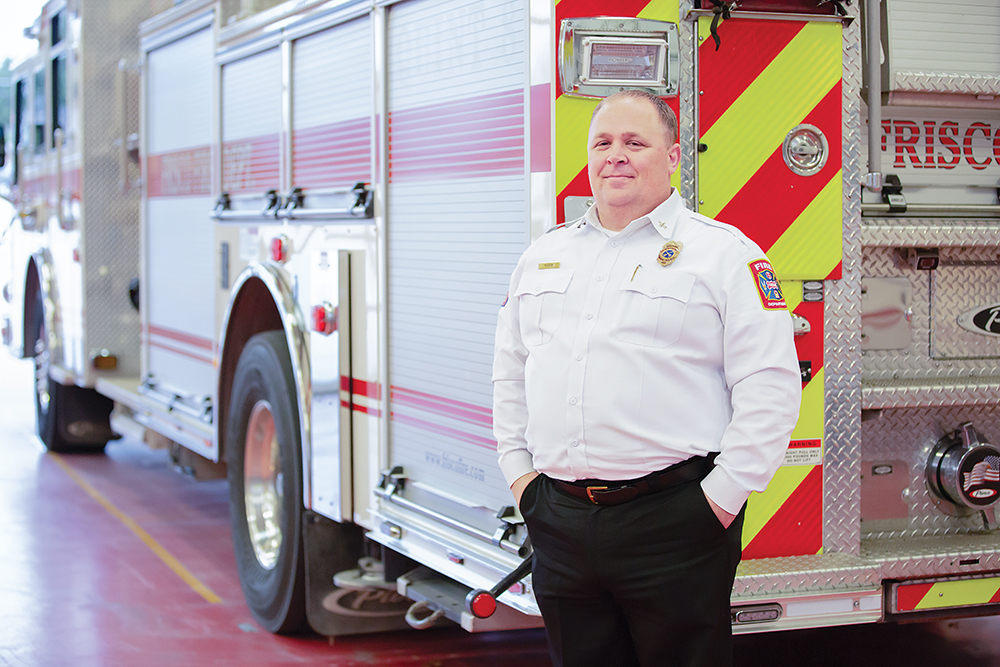
r
The Idea
rr
Dr. Gamber has practiced medicine as an emergency room doctor since 2002 and currently serves at Medical City Plano as an emergency room doctor and with the Frisco Fire Department as the medical director. “The State of Texas says fire departments and paramedics need a medical director and supervising physician and it is truly a partnership,” Dr. Gamber explains. “We are practicing emergency medicine. We are just outside of the hospital.”
rr
Dr. Gamber worked closely with Frisco Fire Department Deputy Chief Vetterick, a 14-year veteran, who has served as both a paramedic and a flight paramedic to formulate the Pre-hospital Amputation Team and Program. Deputy Chief Vetterick says much of his past work as a flight medic played a big part in the creation of this team and program here in Frisco. “As a flight medic, you go on a lot of calls where there are construction accidents and people get pinned and end up needing amputations performed in the field. In Dallas, a couple of hospitals have field amputation programs, so I knew of the existence of them and used them maybe once in my 18 years as a flight medic. In conversations with Dr. Gamber in the year prior to the Frisco accident and program coming to fruition, we knew as Frisco started to grow and we began to see more construction accidents and a wide range of injuries and medical calls in our city that the need would arise soon for a similar program,” Deputy Chief Vetterick recalls. “So, considering the possibilities, we asked ourselves what could we do locally that would not involve bringing a team from Dallas, which can take anywhere from an hour to two hours. We brainstormed over the course of a year or so how we could best utilize the trauma centers that we have in Collin County that really did not even exist five years ago. We thought about how we could leverage their resources and partner with them to create our own program that would be convenient, cost effective and still be able to be accessed quickly and get to the scene quickly. From there, Dr. Gamber leveraged his team.”
rr
There are pieces to a dilemma of this size. Dr. Gamber says, “The Fire Department is going to respond 9-1-1 to the call, but how do you get someone who is trapped out? In the past, we have had a couple of close calls from people getting stuck, and we left the scene often thinking we almost could not get that person out.”
rr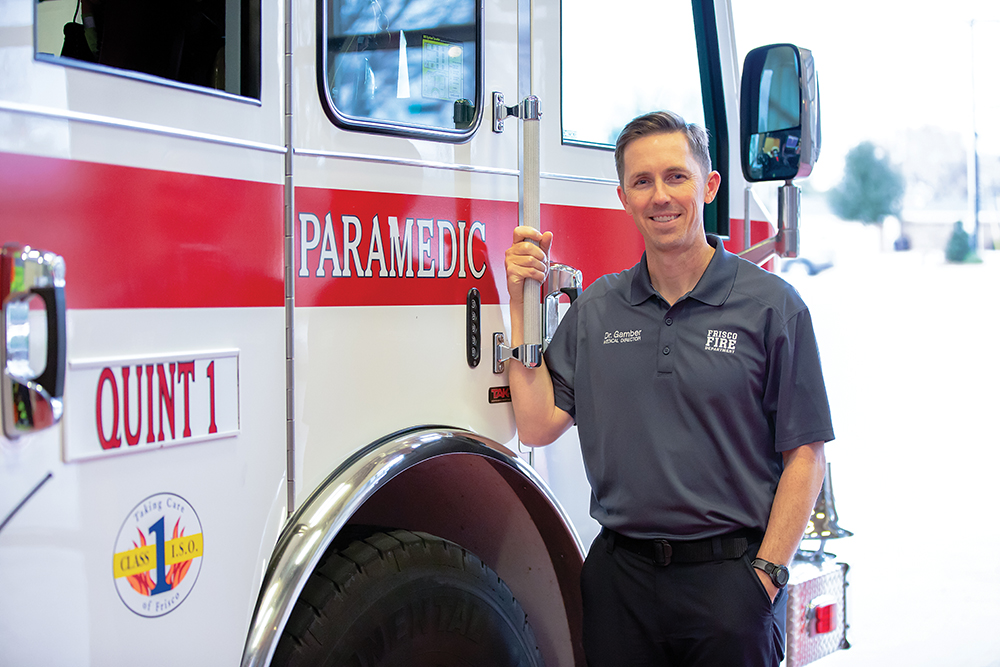
r
Deputy Chief Vetterick and Dr. Gamber explain that, oftentimes, first responders are able to cut machinery away from the patient in order to free them, but not every time. So, based on those conversations, the question ultimately became: how would the Frisco Fire Department be able to get a patient unstuck if they were not able to disassemble the machine? “I had a conversation with our trauma surgery group at Medical City Plano regarding the possibilities. Higher-level trauma centers and hospitals have in-house trauma surgeons 24/7 and they are ready to go any time. With that resource available, I asked them if it would be possible for a trauma surgeon to come out into the field, if we got them a ride to a scene. Of course, it was understood that it more than likely would not happen very often, but when it does, we would need them to come out pretty quickly. They talked about it as a group and decided they had enough back-up coverage that if someone left, they would still be covered at the hospital. They agreed to do it within a reasonable distance, and Frisco was within that distance,” Dr. Gamber explains.
rr
r
From there, the Frisco Fire Department, along with Dr. Gamber, trained and put the plan and program in motion. Dr. Gamber met with the trauma group at the hospital, together with the ER doctors and trauma surgeons. Dr. Gamber says that training included a discussion regarding indications on when first responders want to call the team out. “Obviously, you want to call them when needed, but you do not when it is not. A lot of times, we come back from calls and our job is to think about how it went and what if something else had happened. This stemmed from that same conversation. One of the most important facets of this whole thing is our personnel. We trained and every person on scene that day was absolutely spot-on the day we needed it,” Dr. Gamber recalls.
rr
Making the Call
rr
As Deputy Chief Vetterick explained, the pre-hospital amputation protocol is not one that is used often, so making the determination that the team and protocol are needed is one that has to happen quickly and by a seasoned first responder. “The more tenured you are in the organization and the more calls you have been on, the greater ability you have to identify if they are dealing with a call they will be able to resolve quickly … that is something that is going to take some time. We are blessed and have the benefit of having a Heavy Rescue Unit staffed and ready 24 hours a day. They are able to disassemble a machine around someone who is trapped in it,” Deputy Chief Vetterick says. “So, we have personnel and equipment that are able to pull someone out, but, even then, that takes time. Sometimes, you cannot take the machine apart around a victim and you have to take the person out of the machine.”
rr
Ultimately, the experiences of responders and the seriousness of the situation are the factors in the decision as to whether the pre-hospital amputation team and protocol are needed, and it is a decision that has to be made within the first couple of minutes of response, as responders determine if they can quickly get the patient out or if it is a situation that will require additional resources that might take a longer period of time. “That is where our Pre-hospital Amputation Team becomes a reality, based on the quick assessment of usually a senior officer, lieutenant or captain working with paramedics on the call. They are ultimately asking what the best course of action is for the patient.”
rr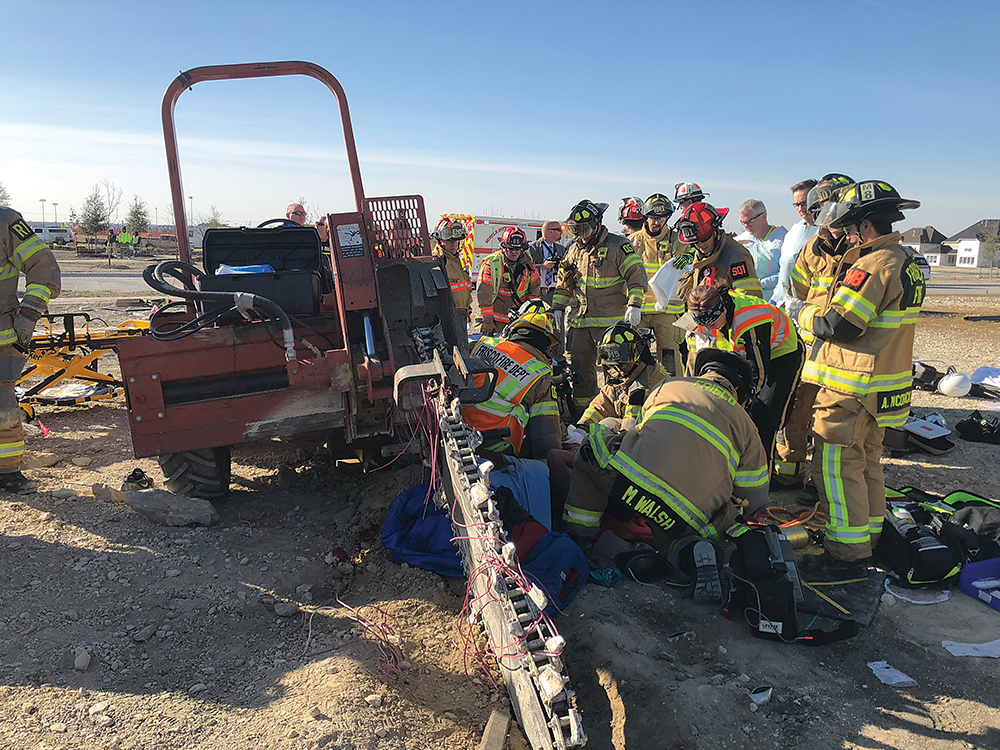
r
The Accident
rr
On February 1, 2018, Francisco Palma, a construction worker, became caught and mangled in the teeth of a piece of ditch-digging machinery that resembles a larger-than-life chainsaw. The machine flipped him over and only his head and shoulders touched the ground.
rr
Looking back on the day, Deputy Chief Vetterick remembers it being quite a busy morning, as firefighters were finishing up working a structure fire at the post office when he and his comrades heard the injured person call off Main Street and Independence Parkway. “There were actually some police officers working an investigation literally across the street, and we have a really great relationship with our police department. They respond to a lot of our calls to provide scene security and, in this case, to provide first aid. So, they reported to the scene and reported what they saw, which was literally a person trapped in a machine — a Ditch Witch®. They tried to apply a tourniquet, but they could not based on the way the patient was caught in the machine. They could not even access the extremity that was caught in the machine,” Deputy Chief Vetterick says. At that point, dispatch upgraded the call to a rescue, and as soon as the lieutenant arrived on scene, within a minute or so of walking up to the patient and analyzing the scene, he notified the battalion chief they were going to need the amputation team. “This is something we would train on probably two months before and were not quite 100 percent sure how we were going to use the protocol, but he knew they needed to and that is when our battalion chiefs started making calls working on getting the pre-hospital amputation team to the site as quickly and as smoothly as we had envisioned. We had a lot of people working backchannels in order to make it happen that day. I was calling Medical City Plano’s radio room, Assistant Chief Kramer was calling Dr. Gamber, the battalion chief was coordinating the actual rescue and the disassembly of the machine, and then our medics were immediately tending to the patient,” Deputy Chief Vetterick shares.
rr
Dr. Gamber was called to the scene and arrived 15-20 minutes later. He was not in the emergency room at Medical City Plano at the time of the accident, so, as he drove, he called the trauma surgeon, Dr. Al West, personally, since this was the first time the protocol and team would come to life and to verify that that it was, in fact “go time,” given the severity of the situation. “We had initially planned to get him here by ground, but we were not sure how fast that was going to happen. We had a helicopter in route to the scene that we were able to re-route to the hospital to pick up Dr. West to get him to us faster. He grabbed the tool kit and the Amputation Team field surgery kit we had prepared when we were getting this protocol together. It was basically a fishing tackle box full of equipment for this procedure. A cooler full of blood was sent with him, as well. A lot of times, with an amputation, you are using a ton of blood and sometimes need a transfusion on scene. The hospital was great and gracious to help us in that time. You know, you think about something you saw in a presentation five months ago and now you have to remember details of that information and put it into play in real life. That is honestly what happened that day,” Dr. Gamber remembers. “Our personnel were spot-on in remembering the presentation we gave in training and remembered it and put it into play. The training, the memory, the retention of information and knowledge, it all really speaks to how hard these guys work and focus on protocols. I got to the scene about the time the helicopter with our trauma surgeon, Dr. West, was arriving. One of the most distinct memories of that day for me was looking at the injury and, it is hard to make me flinch, but it was a rough looking injury. I also remember how well the paramedics had sedated the patient and knew he was comfortable. To this day, he has no memory of the event. He does not remember pain … anything. We had taken what would normally happen in the operating room into a windy, dirty construction area with dirt and dust swirling. The site turned into an operating room. We kept him very comfortable, and that is something I like to think we all take a lot of pride in. We had a helicopter overhead streaming Facebook live, so we had to be careful and cognizant of the patient’s privacy. We understand there will be press on a lot of our scenes, but it did make it a little more complex to have to cover the patient up, too.”
rr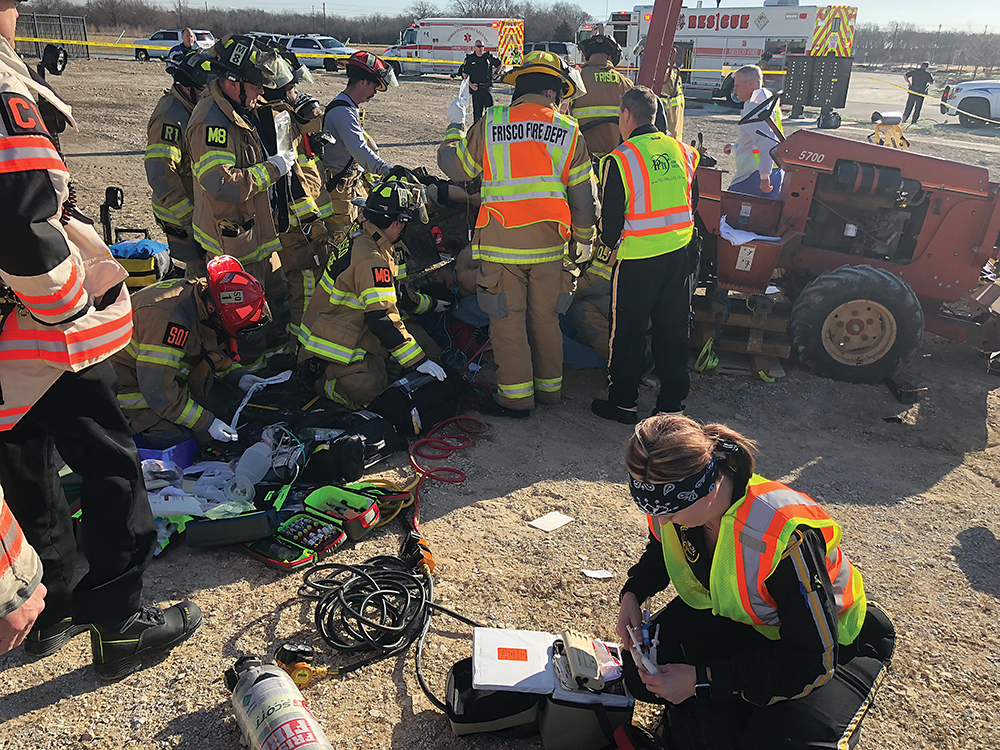
r
There were roughly 20 people on scene doing different things, all working together in symphony towards one goal, which was getting the patient out. Dr. Gamber and Dr. West worked on the amputation, while several others worked on the patient administering medications, fluids, monitoring vital signs and watching his airway, all while a whole other crew worked continuously to disassemble the machine. “We had three or four different tasks going on simultaneously, almost as if they had rehearsed this a dozen times,” Deputy Chief Vetterick says. “Because the patient had been sedated, everyone was working amidst this quiet buzz, getting their jobs done, and people were able to do exactly what they needed to do for their specific task. We had a very successful outcome and various agencies on scene working together. It was so exciting to watch firsthand how smoothly everyone worked together. The actual procedure only took three to four minutes. We really set Dr. West up for success. The patient was sedated and calm, and Dr. West had access to the leg on which he needed to work.”
rr
According to Dr. Gamber, there were four or five facets of the response protocol that the Frisco Fire Department and Dr. Gamber had been training on that all came together on scene, besides just having the surgical team availability, all of which elevated the level of ground-breaking care they were able to give the patient. “As a fire department, this patient was the first person we had administered Tranexamic acid (TXA) to, which is a medication given to treat or prevent blood loss from major trauma. The use of this drug is something we got from military research and we were probably one of the first departments in the area to use it. Once we got him loose, we applied tourniquets, which is fairly cutting-edge in our area. Some of the medications we used for pain and sedation we adopted by keeping up with military research coming out of Afghanistan and Iraq,” he says. Battalion Chief Jake Owen shares, “That was also a first that day. They used a paralytic drug, rocuronium, that helped them obtain an advanced airway in the patient, and in this case, once he was disentangled, they were able to put a breathing tube in.” Dr. Gamber continues, “Dr. West brought blood, as well. We had someone in hemorrhagic shock and one of the things that is paramount is replacing that blood. A lot of training came together for us on this call. We were, and are, obviously, very proud of the patient’s outcome, but the training spoke for itself. We send our trainees to a cadaver lab every month to work on procedures, and the fire department allows me to teach every Tuesday, just on medical practices. The paramedics were basically anesthesiologists during this procedure. They had him sedated and managed his airways and the patient was perfectly calm, just like one would be in an operating room. We salvaged his left leg, which was a huge save given the state of the patient’s legs in the accident. He was flown back in the helicopter with Dr. West and, eventually, underwent multiple surgeries.”
rr
Looking Back and Going Forward
rr
Looking back, Deputy Chief Vetterick remembers a feeling of relief and thankfulness that he, Dr. Gamber and the department had the foresight to put a team and protocol like this in place. “We are blessed that we had the resources and collaborative efforts combined to make this happen. We all thought it was going to happen, we just did not think it was going to happen that quickly after we had solidified the plan,” Deputy Chief Vetterick remembers. “The Pre-hospital Amputation Team is not something you use very often, but when it is needed, it needs to work and can be the difference in life and death for someone. Our crews were able to quickly identify the need and everything fell into place as it needed to.”
rr
For Dr. Gamber, that day was a true testament to the level of care and professionalism first responders were able to give Mr. Palma. “It is scenes like the one that day that remind me how calm and professional our firefighters are. In situations where most people would pass out, they just calmly step in and take care of business, while working together as a team because we train hard. To me, this drove home why we train as hard as we do. I will never forget walking on scene and seeing the severity of the injury and looking down and seeing how calm the patient was. That resonated with me — the fact that our guys were able to work so quickly to get the patient comfortable was one of the things that stood out to me. They were truly functioning like some combination of trauma surgeons and anesthesiologists.”
rr
The team from that day agrees that the success of the protocol all stems from the support their organization receives from the city. “They have provided us the tools, supported our efforts, provided funding to support our training, given us access to our medical director and so many things that have played integral parts in where we are today. Everybody in our city benefits from the resources our city puts towards public safety. It serves as a testament to how well we are supported,” Deputy Chief Vetterick adds.
rr
Setting a Precedent
rr
While the protocol and procedure are not necessarily new, their use in emergency response in Frisco is still relatively new. Surrounding departments have taken notice and can learn much from the model our first responders have created. Dr. Gamber says there are a couple of things other departments can take from the response protocol, depending on the level of training they are able to provide and their proximity to a trauma center. “Not every city will be able to fly in a trauma surgeon or have access to a high-level trauma center, but I think any city can look at this response model and determine what they can allow. Some might be able to afford tourniquets or their budget might allow them tourniquets and the medication TXA. It might simply inspire fire departments to communicate more with their local trauma centers to establish a plan or even just a communication plan. And, to be frank, it truly may be that the realization comes to fruition that a trauma surgeon just might not have to be the one to perform the procedure. If we can train paramedics to identify a need for response to an amputation injury, there is probably very well a future in which you have not just audio, but two-way visual communication on scene that would allow doctors and surgeons to coach trained professionals through situations like this,” Dr. Gamber explains. “Trauma surgeons are buying in. It occurred, it worked and they got positive feedback on how it went. Flexibility is key for this model based on the situations that come up. There might be a time when the ER has gotten two gunshot victims and they are not able to send a trauma surgeon. So, you have to adapt. It might be that they send an ER physician to perform the procedure. As I have gotten to know our paramedics over the past five years, I have come to realize that we can train to do this. They are incredibly skilled at procedures and we have the training resources we need to help them. I think there are, and will be, scenarios where all different kinds of providers and first responders can be of great use in different situations … whether it is single-casualty or mass-casualty.”
rr
Deputy Chief Vetterick knows and believes the response protocol truly is the perfect example of collaborative efforts, given that they took from an idea, made creative work of it and were able to put it in motion. “Hopefully, because of it, we will benefit more people and save more lives. We push the leading-edge of these techniques, resources, models and we cannot stay stagnant,” Deputy Chief Vetterick admits. “The beauty of the protocol is that it really is now a regional protocol. Cities have seen it work and now they are buying in. Cities can work in concert with their hospitals to determine if such a response is possible.”
rr
As the Frisco Fire Department together with the City and Dr. Gamber go forward, there is no doubt they will continue to push the envelope in the name of providing the best care for citizens. Frisco has set the bar high, in many facets, and Dr. Gamber and the Fire Department, as a whole, have not only set that bar, but raised it. Dr. Gamber says, “We are in a really exciting area of medicine … the most exciting area of medicine, if you ask me. There is a huge focus now on pre-hospital emergency care and we are the biggest group practice of emergency medicine in Frisco. Our job is to take the most current research and sometimes leave the hospital … not get so far out that the medical community does not understand what we are doing, but always push the envelope while answering the question ‘Would I want this to happen for my family?’ We live and work in the city. I have kids in the school district and we truly do think a lot about our families and how things will work. You will always see that Frisco is one of the most advanced EMS delivery systems in the country.”
rr
Allie Spletter is a freelance writer who is proud to call Frisco home. She loves being able to share Frisco with others through writing.


